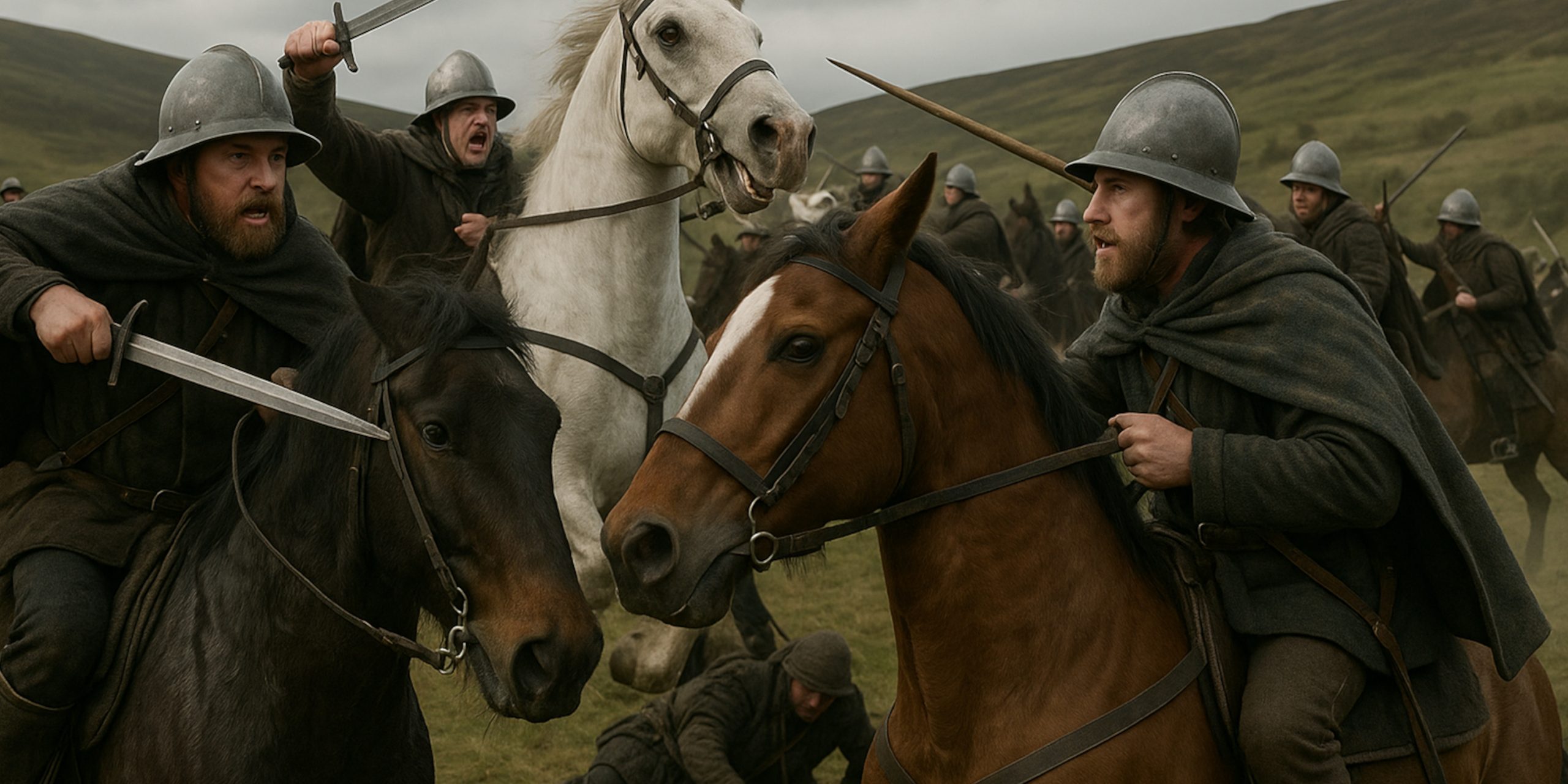
The Border Reiver era, spanning roughly from the late 13th to early 17th centuries, saw the Anglo-Scottish frontier plagued by raids, skirmishes, and blood feuds. While much of the conflict consisted of cattle theft and retaliatory strikes by local clans, several larger military actions punctuated the period, often involving royal armies or the Wardens of the Marches. These battles were shaped by the rugged terrain, fractured loyalties, and the brutal nature of frontier life.
Forces
The nature of warfare along the Anglo-Scottish Border was fluid, with loyalty often owed more to kin than crown. Both the English and Scottish sides organised their frontier into Marches: East, Middle, and West. Each March was overseen by a Warden, tasked with maintaining law and order. Forces raised for larger engagements were typically drawn from:
- Local levies: Compelled by feudal duty or warden command
- Reiver families: Armed riders acting out of loyalty or profit
- Royal troops: Occasionally deployed from Edinburgh or London to suppress disorder
- Mercenaries: Particularly in later years, including hired lances and archers
The composition was therefore mixed, with irregular cavalry, lightly armed footmen, and only occasional use of artillery.
Arms and Armour
| Type | Description |
|---|---|
| Steel Bonnets | Common helmet worn by Reivers and troops on both sides |
| Jacks of Plate | Quilted jackets with small steel plates sewn in, ideal for mounted raiders |
| Targe Shields | Small round shields, often reinforced with iron bosses |
| Lances and Spears | Used by mounted men for charges or skirmishes |
| Swords & Dirks | Favoured for close combat; basket-hilted swords appeared in later periods |
| Arquebuses | Increasingly common by the late 16th century, but not widespread |
| Bows & Crossbows | Longbows remained in use, particularly on the English side |
Key Leaders and Troop Composition
| Battle / Skirmish | Date | English Leaders | Scottish Leaders | Estimated Troops |
|---|---|---|---|---|
| Battle of Solway Moss | 24 Nov 1542 | Sir Thomas Wharton | Lord Maxwell | ~3,000 Scots vs 3,000 English |
| Raid of the Redeswire | 7 Jul 1575 | Sir John Forster (Warden) | Sir John Carmichael (Warden) | ~200 each side |
| Battle of Ancrum Moor | 27 Feb 1545 | Sir Ralph Eure, Sir Brian Layton | Earl of Angus, Scott of Buccleuch | ~3,000 English vs 2,500 Scots |
| Skirmish at Dryfe Sands | 6 Dec 1593 | Johnstone allies (Scottish side) | Clan Maxwell | ~1,000 combined |
Notably, many of these confrontations blurred the line between feud and battle, with personal and clan vendettas erupting into military-scale violence.
Archaeology
Archaeological evidence of Reiver battles is sparse due to the nature of the warfare—small-scale, fast-moving, and often fought in isolated valleys. However, several finds support the written accounts:
- Recovered steel bonnets and jack fragments near the Solway and in Liddesdale
- Arrowheads and musket balls unearthed at Ancrum Moor and Dryfe Sands
- Ruined peel towers and bastle houses, including remains scorched by raids
- Mass graves near known battle sites, though often unmarked and local in tradition
The Peel towers themselves, used as defensive homes by prominent families, remain some of the most evocative structures of the period.
Battle Timeline
| Year | Event | Description |
|---|---|---|
| 1370s | Rise of Reiver activity | Marked increase in raiding after Anglo-Scottish conflicts weakened central control |
| 1513 | Flodden aftermath | Power vacuum on Scottish side intensified cross-border raids |
| 1542 | Battle of Solway Moss | English capture of hundreds of Scots; weakened James V |
| 1545 | Battle of Ancrum Moor | Decisive Scottish victory over English incursion |
| 1575 | Raid of the Redeswire | Final major border skirmish; ended in parley, but deaths on both sides |
| 1593 | Dryfe Sands | Blood feud between Johnstone and Maxwell clans; decisive and bloody |
Contemporary Quotes
“Every man hath his steal bonnet, his plate jack, and a spear to it.”
— Thomas Musgrave of Bewcastle
“The Marches are so full of blood and thievery, that justice comes too late and mercy is counted cowardice.”
— Sir Robert Carey, Warden of the English Middle March
“Buccleuch, we have broken your band, and burned your land.”
— Part of a traditional Scottish war cry from the Johnstones
These battles were often eruptions of centuries of resentment, driven by clan honour, royal neglect, and the rugged frontier that nurtured a culture of vengeance. Though often overshadowed by larger national wars, the battles of the Reiver era shaped identities on both sides of the Border. Many names and ruins still bear witness to that legacy.



